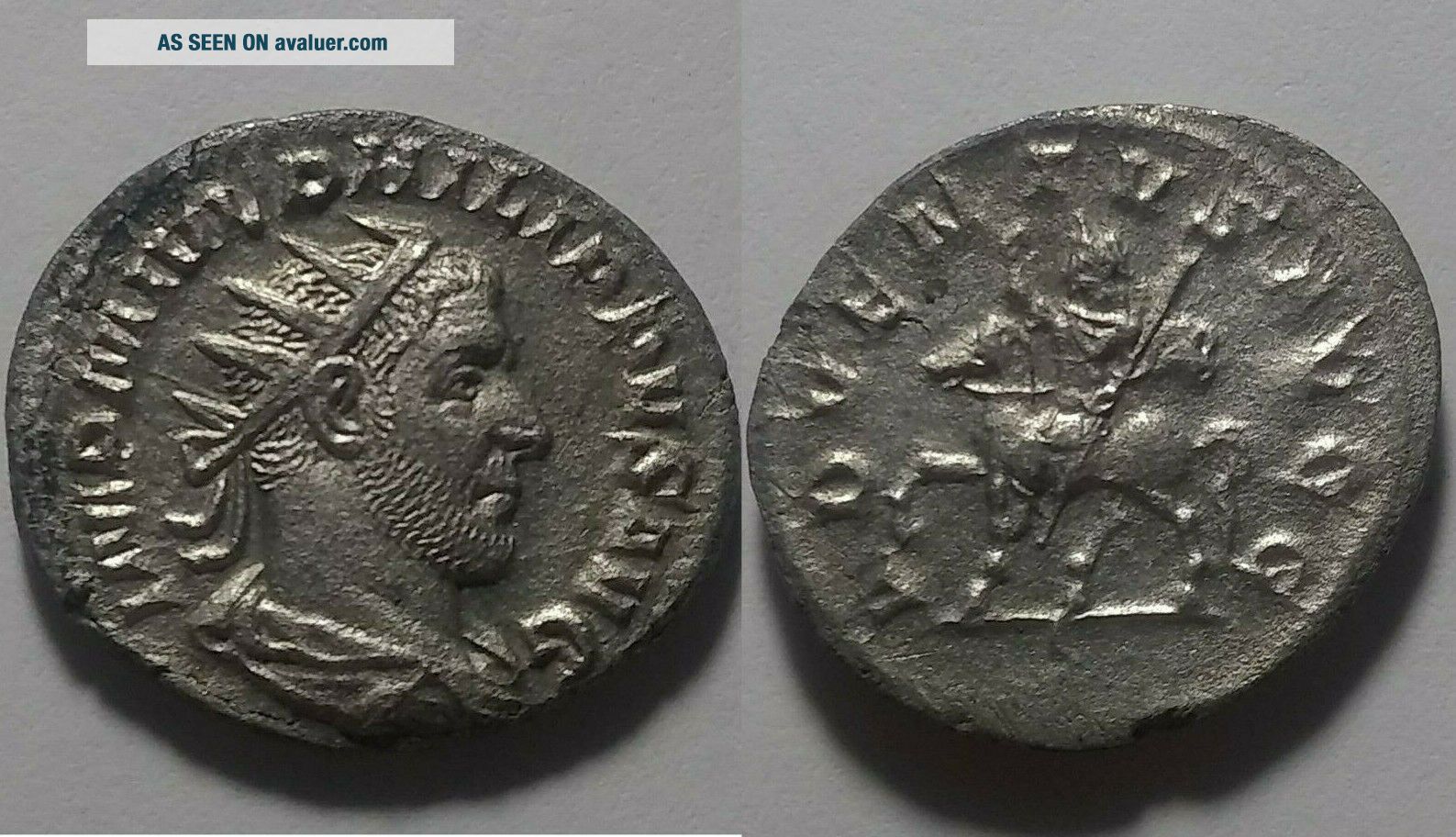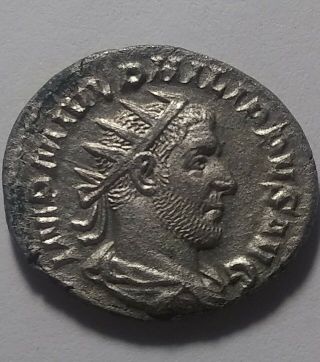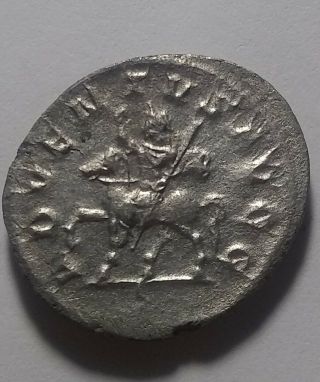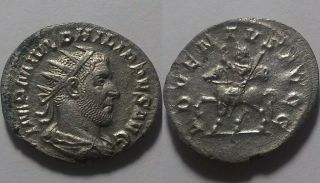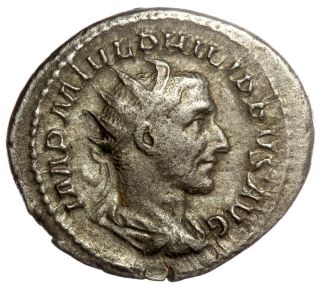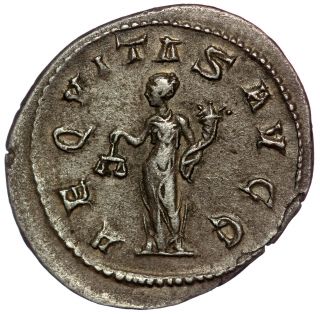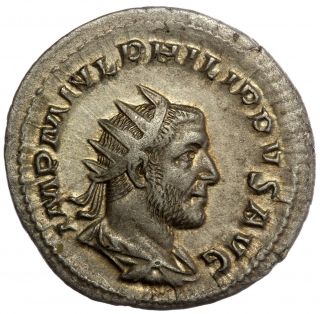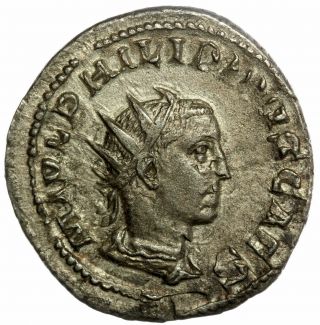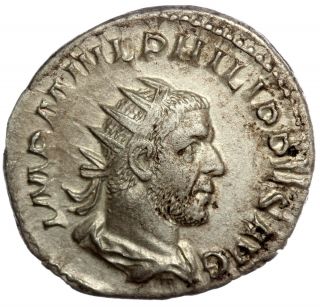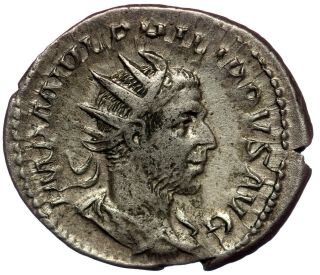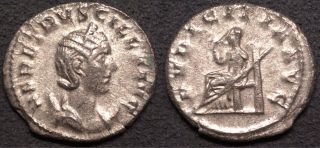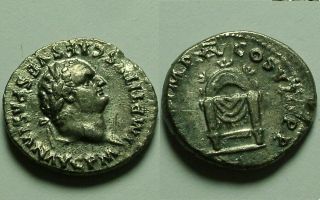Rare Ancient Roman Silver Coin AR Antoninianus Philip I Arab 248 AD Horse Rider
Item History & Price
| Reference Number: Avaluer:9901612 | Date: 248 |
| Denomination: Antoninianus | Composition: Silver |
| Material: silver | Ruler: Philip I |
One original ancient Roman coin antoninianus of: Emperor Philip I, the Arab; AD 244-249.Silver antoninianus 21-23mm. Genuine and original tone. (EF) Obv./ IMP M IVL PHILIPPVS AVG, radiate bust right.Rev./ ADVENTVS AVGG, Philip on horseback left raising hand.
RIC 26b, RSC 3.Authenticity guaranteed!!!
Marcus Julius Philippus (Latin: Marcus Julius PhilippusAugustus [a] c. 204 – September 249 AD), also known commonly by his nicknamePhilip the Arab (Latin: Philippus Arabus, al...so known as Philip or Philip I), was Roman Emperor from February 244 to September 249. He was born in ArabiaPetraea, the Roman province of Arabia, in a city situated in modern-day Syria.He went on to become a major figure in the Roman Empire. After the death ofGordian III in February 244, Philip, who had been Praetorian prefect, achievedpower. He quickly negotiated peace with the Persian Sassanid Empire. During hisreign, the city of Rome celebrated its millennium. Among early Christian writers, Philip had the reputation of beingsympathetic to the Christian faith. Probably for this reason, it was evenclaimed by some that he had converted to Christianity, which would have madehim the first Christian emperor. He supposedly tried to celebrate Easter withChristians in Antioch, but the bishop Saint Babylas made him stand with thepenitents. Philip and his wife received letters from Origen. Philip was betrayed and killed at the Battle of Verona inSeptember 249 following a rebellion led by his successor, Gaius Messius QuintusDecius.Little is known about Philip's early life and politicalcareer. He was born in what is today Shahba, Syria, about 90 kilometres (56 mi)southeast of Damascus, in the Trachonitis district. At the time this was in theRoman province of Arabia, and Glen Bowersock believes that Philip was indeed ofArab origin.He was the son of a local citizen, Julius Marinus, possibly of someimportance. Allegations from later Roman sources (Historia Augusta and Epitomede Caesaribus) that Philip had a very humble origin or even that his father wasa leader of brigands are not accepted by modern historians. While the name of Philip's mother is unknown, he did have abrother, Gaius Julius Priscus, an equestrian and a member of the PraetorianGuard under Gordian III (238–244). In 234, Philip married Marcia OtaciliaSevera, daughter of a Roman Governor. They had three children, a son namedMarcus Julius Philippus Severus (Philippus II), born in 238, a daughter calledJulia Severa or Severina who is known from numismatic evidence but is nevermentioned by the ancient Roman sources and a son named Quintus PhilippusSeverus, born in 247.Philip's rise to prominence began through the interventionof his brother Priscus, who was an important official under the emperor GordianIII. His big break came in 243, during Gordian III's campaign against Shapur Iof Persia, when the Praetorian prefect Timesitheus died under unclearcircumstances. At the suggestion of his brother Priscus, Philip became thenew Praetorian prefect, with the intention that the two brothers would controlthe young Emperor and rule the Roman world as unofficial regents.Following amilitary defeat, Gordian III died in February 244 under circumstances that arestill debated. While some claim that Philip conspired in his murder, otheraccounts (including one coming from the Persian point of view) state thatGordian died in battle. Whatever the case, Philip assumed the purple robefollowing Gordian's death. According to Edward Gibbon: His rise from soobscure a station to the first dignities of the empire seems to prove that hewas a bold and able leader. But his boldness prompted him to aspire to thethrone, and his abilities were employed to supplant, not to serve, hisindulgent master. Philip was not willing to repeat the mistakes of previousclaimants, and was aware that he had to return to Rome in order to secure hisposition with the senate. However, his first priority was to conclude a peacetreaty with Shapur I of Persia, and withdraw the army from a potentially disastroussituation.Although Philip was accused of abandoning territory, the actual termsof the peace were not as humiliating as they could have been.[16] Philipapparently retained Timesitheus’ reconquest of Osroene and Mesopotamia, but hehad to agree that Armenia lay within Persia's sphere of influence. He also hadto pay an enormous indemnity to the Persians of 500, 000 gold denarii.Philip immediately issued coins proclaiming that he had made peace with thePersians (pax fundata cum Persis). Leading his army back up the Euphrates, south of CircesiumPhilip erected a cenotaph in honor of Gordian III, but his ashes were sentahead to Rome, where he arranged for Gordian III's deification. Whilst inAntioch, he left his brother Priscus as extraordinary ruler of the Easternprovinces, with the title of rector Orientis. Moving westward, he gave hisbrother-in-law Severianus control of the provinces of Moesia and Macedonia. Heeventually arrived in Rome in the late summer of 244, where he was confirmedAugustus. Before the end of the year, he nominated his young son Caesar andheir, his wife, Otacilia Severa, was named Augusta, and he also deified hisfather Marinus, even though the latter had never been emperor. While in Rome, Philip also claimed an official victory over the Persians with the titles ofParthicus Adiabenicus, Persicus Maximus and Parthicus Maximus.ReignIn an attempt to shore up his regime, Philip put a greatdeal of effort in maintaining good relations with the Senate, and from thebeginning of his reign, he reaffirmed the old Roman virtues and traditions. Hequickly ordered an enormous building program in his home town, renaming itPhilippopolis, and raising it to civic status, while he populated it withstatues of himself and his family. This creation of a new city, piled on top ofthe massive tribute owed to the Persians, as well as the necessary donative tothe army to secure its acceptance of his accession, meant Philip wasdesperately short of money. To pay for it, he ruthlessly increased levels oftaxation, while at the same time he ceased paying subsidies to the tribes northof the Danube that were vital for keeping the peace on the frontiers. Bothdecisions would have significant impacts upon the empire and his reign.In 245, Philip was forced to leave Rome as the stabilityestablished by Timesitheus was undone by a combination of his death, Gordian'sdefeat in the east and Philip's decision to cease paying the subsidies. TheCarpi moved through Dacia, crossed the Danube and emerged in Moesia where theythreatened the Balkans. Establishing his headquarters in Philippopolis inThrace, he pushed the Carpi across the Danube and chased them back into Dacia, so that by the summer of 246, he claimed victory against them, along with the title"Carpicus Maximus". In the meantime, the Arsacids of Armenia refusedto acknowledge the authority of the Persian king Shapur I, and war with Persiaflared up again by 245.Ludi Saeculares Nevertheless, Philip was back in Rome by August 247, wherehe poured more money into the most momentous event of his reign – the LudiSaeculares, which coincided with the one thousandth anniversary of thefoundation of Rome. So in April 248 AD (April 1000 A.U.C.), Philip had thehonor of leading the celebrations of the one thousandth birthday of Rome, whichaccording to tradition was founded on April 21, 753 BC by Romulus.Commemorative coins, such as the one illustrated here, were issued in largenumbers and, according to contemporary accounts, the festivities weremagnificent and included spectacular games, ludi saeculares, and theatricalpresentations throughout the city. In the Colosseum, in what had been originallyprepared for Gordian III's planned Roman triumph over the Persians, morethan 1, 000 gladiators were killed along with hundreds of exotic animalsincluding hippos, leopards, lions, giraffes, and one rhinoceros. The eventswere also celebrated in literature, with several publications, includingAsinius Quadratus's History of a Thousand Years, specially prepared for theanniversary. At the same time, Philip elevated his son to the rank ofco-Augustus.Downfall Despite the festive atmosphere, there were continuedproblems in the provinces. In late 248, the legions of Pannonia and Moesia, dissatisfied with the result of the war against the Carpi, rebelled andproclaimed Tiberius Claudius Pacatianus emperor. The confusion that this entailedtempted the Quadi and other Germanic tribes to cross the frontier and raidPannonia. At the same time, the Goths invaded Moesia and Thrace across theDanube frontier, and laid siege to Marcianopolis, as the Carpi, encouragedby the Gothic incursions, renewed their assaults in Dacia and Moesia.Meanwhile, in the East, Marcus Jotapianus led another uprising in response tothe oppressive rule of Priscus and the excessive taxation of the Easternprovinces. Two other usurpers, Marcus Silbannacus and Sponsianus, arereported to have started rebellions without much success. Overwhelmed by the number of invasions and usurpers, Philipoffered to resign, but the Senate decided to throw its support behind theemperor, with a certain Gaius Messius Quintus Decius most vocal of all the senators.Philip was so impressed by his support that he dispatched Decius to the regionwith a special command encompassing all of the Pannonian and Moesian provinces.This had a dual purpose of both quelling the rebellion of Pacatianus as well asdealing with the barbarian incursions. Although Decius managed to quell the revolt, discontent inthe legions was growing. Decius was proclaimed emperor by the Danubian armiesin the spring of 249 and immediately marched on Rome.[36] Yet even before hehad left the region, the situation for Philip had turned even more sour.Financial difficulties had forced him to debase the Antoninianus, as riotingbegan to occur in Egypt, causing disruptions to Rome's wheat supply and furthereroding Philip's support in the capital. Although Decius tried to come to terms with Philip, Philip'sarmy met the usurper near modern Verona that summer. Decius easily won thebattle and Philip was killed sometime in September 249, either in the fightingor assassinated by his own soldiers who were eager to please the new ruler.Philip'seleven-year-old son and heir may have been killed with his father and Priscus disappearedwithout a trace. Some later traditions, first mentioned in the historianEusebius in his Ecclesiastical History, held that Philip was the firstChristian Roman Emperor. According to Eusebius (Ecc. Hist. VI.34), Philip was aChristian, but was not allowed to enter Easter vigil services until heconfessed his sins and ordered to sit among the penitents, which he didwillingly. Later versions located this event in Antioch. However, historians generally identify the later EmperorConstantine, baptized on his deathbed, as the first Christian emperor, andgenerally describe Philip's adherence to Christianity as dubious, becausenon-Christian writers do not mention the fact, and because throughout hisreign, Philip to all appearances (coinage, etc.) continued to follow the statereligion. Critics ascribe Eusebius' claim as probably due to the tolerancePhilip showed towards Christians.Please make your payments on time or contact us to arrange.
Payment methods for USA buyers:< PAYPAL Payment methods for International buyers - including Canada: PAYPAL contact us for more info.Payments must be received within 7 days from the end of auction (14 days for international). Please be sure to include item # & address with your payment.
IF REQUESTING A CERTIFICATE PLEASE DO SO AT THE TIME OF PAYMENT. Pay me securely with any major credit card through PayPal! Items will be shipped within 1 to 3 business days of purchase completion.
FREE DOMESTIC SHIPPING. INTERNATIONAL - $9.99 (REGISTERED-$25.00) WE COMBINE SHIPPING.
If you would like to have special shipping, please contact us. All items will be sent out in protected envelope and boxed if necessary. YOU ARE BIDDING ON AN ANCIENT ITEM(S) AS DESCRIBED AND PICTURED ABOVE!!!
Every item offered by cameleoncoins is unconditionally guaranteed to be genuine & authentic. We can provide a certificate of authenticity or extended return policy by request only!!! Please include 5 dollars and a short request with your payment if you would like a COA!!! If in the unlikely event that an item is found to be reproduction, full return privileges are within 14 days of receiving the coins. We will promptly offer a full refund without hesitation or hassle. Please read the auction page prior to contacting US.
RIC 26b, RSC 3.Authenticity guaranteed!!!
Marcus Julius Philippus (Latin: Marcus Julius PhilippusAugustus [a] c. 204 – September 249 AD), also known commonly by his nicknamePhilip the Arab (Latin: Philippus Arabus, al...so known as Philip or Philip I), was Roman Emperor from February 244 to September 249. He was born in ArabiaPetraea, the Roman province of Arabia, in a city situated in modern-day Syria.He went on to become a major figure in the Roman Empire. After the death ofGordian III in February 244, Philip, who had been Praetorian prefect, achievedpower. He quickly negotiated peace with the Persian Sassanid Empire. During hisreign, the city of Rome celebrated its millennium. Among early Christian writers, Philip had the reputation of beingsympathetic to the Christian faith. Probably for this reason, it was evenclaimed by some that he had converted to Christianity, which would have madehim the first Christian emperor. He supposedly tried to celebrate Easter withChristians in Antioch, but the bishop Saint Babylas made him stand with thepenitents. Philip and his wife received letters from Origen. Philip was betrayed and killed at the Battle of Verona inSeptember 249 following a rebellion led by his successor, Gaius Messius QuintusDecius.Little is known about Philip's early life and politicalcareer. He was born in what is today Shahba, Syria, about 90 kilometres (56 mi)southeast of Damascus, in the Trachonitis district. At the time this was in theRoman province of Arabia, and Glen Bowersock believes that Philip was indeed ofArab origin.He was the son of a local citizen, Julius Marinus, possibly of someimportance. Allegations from later Roman sources (Historia Augusta and Epitomede Caesaribus) that Philip had a very humble origin or even that his father wasa leader of brigands are not accepted by modern historians. While the name of Philip's mother is unknown, he did have abrother, Gaius Julius Priscus, an equestrian and a member of the PraetorianGuard under Gordian III (238–244). In 234, Philip married Marcia OtaciliaSevera, daughter of a Roman Governor. They had three children, a son namedMarcus Julius Philippus Severus (Philippus II), born in 238, a daughter calledJulia Severa or Severina who is known from numismatic evidence but is nevermentioned by the ancient Roman sources and a son named Quintus PhilippusSeverus, born in 247.Philip's rise to prominence began through the interventionof his brother Priscus, who was an important official under the emperor GordianIII. His big break came in 243, during Gordian III's campaign against Shapur Iof Persia, when the Praetorian prefect Timesitheus died under unclearcircumstances. At the suggestion of his brother Priscus, Philip became thenew Praetorian prefect, with the intention that the two brothers would controlthe young Emperor and rule the Roman world as unofficial regents.Following amilitary defeat, Gordian III died in February 244 under circumstances that arestill debated. While some claim that Philip conspired in his murder, otheraccounts (including one coming from the Persian point of view) state thatGordian died in battle. Whatever the case, Philip assumed the purple robefollowing Gordian's death. According to Edward Gibbon: His rise from soobscure a station to the first dignities of the empire seems to prove that hewas a bold and able leader. But his boldness prompted him to aspire to thethrone, and his abilities were employed to supplant, not to serve, hisindulgent master. Philip was not willing to repeat the mistakes of previousclaimants, and was aware that he had to return to Rome in order to secure hisposition with the senate. However, his first priority was to conclude a peacetreaty with Shapur I of Persia, and withdraw the army from a potentially disastroussituation.Although Philip was accused of abandoning territory, the actual termsof the peace were not as humiliating as they could have been.[16] Philipapparently retained Timesitheus’ reconquest of Osroene and Mesopotamia, but hehad to agree that Armenia lay within Persia's sphere of influence. He also hadto pay an enormous indemnity to the Persians of 500, 000 gold denarii.Philip immediately issued coins proclaiming that he had made peace with thePersians (pax fundata cum Persis). Leading his army back up the Euphrates, south of CircesiumPhilip erected a cenotaph in honor of Gordian III, but his ashes were sentahead to Rome, where he arranged for Gordian III's deification. Whilst inAntioch, he left his brother Priscus as extraordinary ruler of the Easternprovinces, with the title of rector Orientis. Moving westward, he gave hisbrother-in-law Severianus control of the provinces of Moesia and Macedonia. Heeventually arrived in Rome in the late summer of 244, where he was confirmedAugustus. Before the end of the year, he nominated his young son Caesar andheir, his wife, Otacilia Severa, was named Augusta, and he also deified hisfather Marinus, even though the latter had never been emperor. While in Rome, Philip also claimed an official victory over the Persians with the titles ofParthicus Adiabenicus, Persicus Maximus and Parthicus Maximus.ReignIn an attempt to shore up his regime, Philip put a greatdeal of effort in maintaining good relations with the Senate, and from thebeginning of his reign, he reaffirmed the old Roman virtues and traditions. Hequickly ordered an enormous building program in his home town, renaming itPhilippopolis, and raising it to civic status, while he populated it withstatues of himself and his family. This creation of a new city, piled on top ofthe massive tribute owed to the Persians, as well as the necessary donative tothe army to secure its acceptance of his accession, meant Philip wasdesperately short of money. To pay for it, he ruthlessly increased levels oftaxation, while at the same time he ceased paying subsidies to the tribes northof the Danube that were vital for keeping the peace on the frontiers. Bothdecisions would have significant impacts upon the empire and his reign.In 245, Philip was forced to leave Rome as the stabilityestablished by Timesitheus was undone by a combination of his death, Gordian'sdefeat in the east and Philip's decision to cease paying the subsidies. TheCarpi moved through Dacia, crossed the Danube and emerged in Moesia where theythreatened the Balkans. Establishing his headquarters in Philippopolis inThrace, he pushed the Carpi across the Danube and chased them back into Dacia, so that by the summer of 246, he claimed victory against them, along with the title"Carpicus Maximus". In the meantime, the Arsacids of Armenia refusedto acknowledge the authority of the Persian king Shapur I, and war with Persiaflared up again by 245.Ludi Saeculares Nevertheless, Philip was back in Rome by August 247, wherehe poured more money into the most momentous event of his reign – the LudiSaeculares, which coincided with the one thousandth anniversary of thefoundation of Rome. So in April 248 AD (April 1000 A.U.C.), Philip had thehonor of leading the celebrations of the one thousandth birthday of Rome, whichaccording to tradition was founded on April 21, 753 BC by Romulus.Commemorative coins, such as the one illustrated here, were issued in largenumbers and, according to contemporary accounts, the festivities weremagnificent and included spectacular games, ludi saeculares, and theatricalpresentations throughout the city. In the Colosseum, in what had been originallyprepared for Gordian III's planned Roman triumph over the Persians, morethan 1, 000 gladiators were killed along with hundreds of exotic animalsincluding hippos, leopards, lions, giraffes, and one rhinoceros. The eventswere also celebrated in literature, with several publications, includingAsinius Quadratus's History of a Thousand Years, specially prepared for theanniversary. At the same time, Philip elevated his son to the rank ofco-Augustus.Downfall Despite the festive atmosphere, there were continuedproblems in the provinces. In late 248, the legions of Pannonia and Moesia, dissatisfied with the result of the war against the Carpi, rebelled andproclaimed Tiberius Claudius Pacatianus emperor. The confusion that this entailedtempted the Quadi and other Germanic tribes to cross the frontier and raidPannonia. At the same time, the Goths invaded Moesia and Thrace across theDanube frontier, and laid siege to Marcianopolis, as the Carpi, encouragedby the Gothic incursions, renewed their assaults in Dacia and Moesia.Meanwhile, in the East, Marcus Jotapianus led another uprising in response tothe oppressive rule of Priscus and the excessive taxation of the Easternprovinces. Two other usurpers, Marcus Silbannacus and Sponsianus, arereported to have started rebellions without much success. Overwhelmed by the number of invasions and usurpers, Philipoffered to resign, but the Senate decided to throw its support behind theemperor, with a certain Gaius Messius Quintus Decius most vocal of all the senators.Philip was so impressed by his support that he dispatched Decius to the regionwith a special command encompassing all of the Pannonian and Moesian provinces.This had a dual purpose of both quelling the rebellion of Pacatianus as well asdealing with the barbarian incursions. Although Decius managed to quell the revolt, discontent inthe legions was growing. Decius was proclaimed emperor by the Danubian armiesin the spring of 249 and immediately marched on Rome.[36] Yet even before hehad left the region, the situation for Philip had turned even more sour.Financial difficulties had forced him to debase the Antoninianus, as riotingbegan to occur in Egypt, causing disruptions to Rome's wheat supply and furthereroding Philip's support in the capital. Although Decius tried to come to terms with Philip, Philip'sarmy met the usurper near modern Verona that summer. Decius easily won thebattle and Philip was killed sometime in September 249, either in the fightingor assassinated by his own soldiers who were eager to please the new ruler.Philip'seleven-year-old son and heir may have been killed with his father and Priscus disappearedwithout a trace. Some later traditions, first mentioned in the historianEusebius in his Ecclesiastical History, held that Philip was the firstChristian Roman Emperor. According to Eusebius (Ecc. Hist. VI.34), Philip was aChristian, but was not allowed to enter Easter vigil services until heconfessed his sins and ordered to sit among the penitents, which he didwillingly. Later versions located this event in Antioch. However, historians generally identify the later EmperorConstantine, baptized on his deathbed, as the first Christian emperor, andgenerally describe Philip's adherence to Christianity as dubious, becausenon-Christian writers do not mention the fact, and because throughout hisreign, Philip to all appearances (coinage, etc.) continued to follow the statereligion. Critics ascribe Eusebius' claim as probably due to the tolerancePhilip showed towards Christians.Please make your payments on time or contact us to arrange.
Payment methods for USA buyers:< PAYPAL Payment methods for International buyers - including Canada: PAYPAL contact us for more info.Payments must be received within 7 days from the end of auction (14 days for international). Please be sure to include item # & address with your payment.
IF REQUESTING A CERTIFICATE PLEASE DO SO AT THE TIME OF PAYMENT. Pay me securely with any major credit card through PayPal! Items will be shipped within 1 to 3 business days of purchase completion.
FREE DOMESTIC SHIPPING. INTERNATIONAL - $9.99 (REGISTERED-$25.00) WE COMBINE SHIPPING.
If you would like to have special shipping, please contact us. All items will be sent out in protected envelope and boxed if necessary. YOU ARE BIDDING ON AN ANCIENT ITEM(S) AS DESCRIBED AND PICTURED ABOVE!!!
Every item offered by cameleoncoins is unconditionally guaranteed to be genuine & authentic. We can provide a certificate of authenticity or extended return policy by request only!!! Please include 5 dollars and a short request with your payment if you would like a COA!!! If in the unlikely event that an item is found to be reproduction, full return privileges are within 14 days of receiving the coins. We will promptly offer a full refund without hesitation or hassle. Please read the auction page prior to contacting US.



